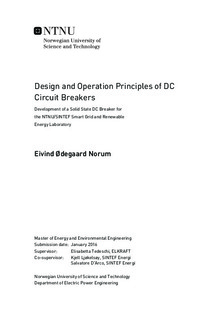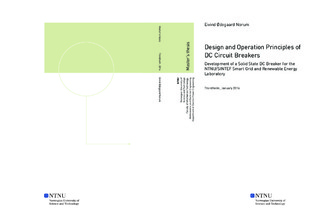| dc.description.abstract | Exciting high voltage direct current (HVDC) transmission systems are mainly point-to-point connections. A multi-terminal HVDC grid consisting of three or more inter connected converter stations is suggested in order to increase the reliability, redundancy and flexibility in long distant bulk power transmission. Similar to AC (alternating current) grids, a protection system of HVDC-grids must be able to clear faults without affecting the remaining healthy parts of the grid. Thus, there is a need for HVDC circuit breakers, in which development is challenging:
The circuit breaker must interrupt the current typically within 5 ms.
The circuit breaker itself must provide the zero current crossing, as no natural zero crossing
is exciting in DC grids.
The circuit breaker must dissipate the magnetic energy provided by the line inductance
The circuit breaker must withstand residual overvoltages after current interruption
This master thesis describes the development of a solid state dc circuit breaker for the DC grid in the NTNU/SINTEF Smart Grid and Renewable Energy Systems Laboratory. The DC breaker main components are Insulated bipolar gate transistors (IGBT) and metal oxide varistors (MOV). Under normal operation the IGBTs are placed in series with the DCline. The current commutates the current into a parallelMOV if current interruption is demanded. The MOV provides subsequently a counter voltage and forces the current to zero.
A test model was assembled initially and corresponding simplified PSCAD simulation model
was developed in order to gain a deeply understanding of the operation of a DC breaker and facilitate the selection of components and the design of the DC breaker for the SINTEF/NTNU laboratory.
The selection of components for the DC breaker was based on the results from the experimental activities. In addition, corresponding ratings were obtained in an adjusted PSCAD model, which included an electro thermal equivalent circuit for temperature calculations. A developed theoretical background including the components used in the DC breaker and general techniques of DC current interruption supported the work. Design guidelines for HVDC breaker based on the experiences from the work were also developed. | |

